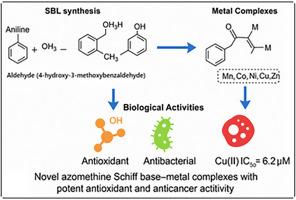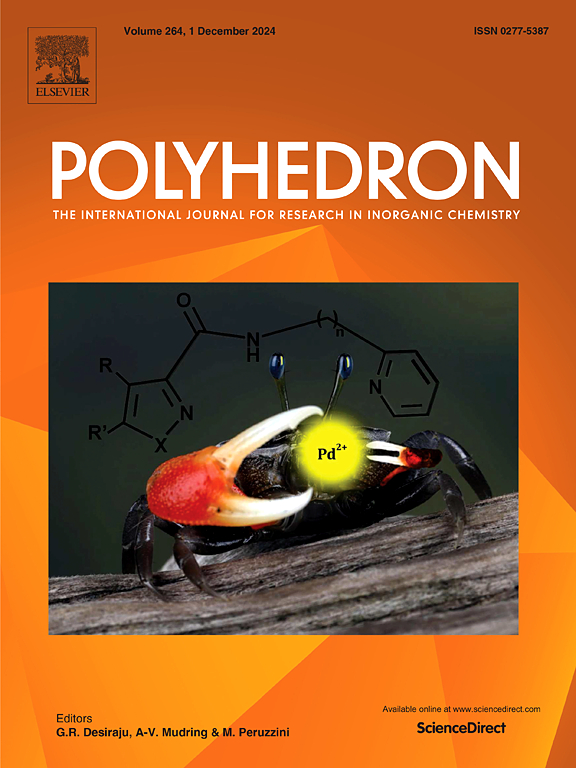Synthesis, characterization, and biological evaluation of Schiff base ligand and their metal complexes: implications for coordination chemistry and biomedical applications
IF 2.6
3区 化学
Q2 CHEMISTRY, INORGANIC & NUCLEAR
引用次数: 0
Abstract
“Schiff base Metal Complex” (SBMC) have received increased attention in coordination chemistry for their versatility and promising biomedical applications in the last decade. The target of this research includes the composite, characterization and biological evaluation of “Schiff base Ligand” (SBL) as well as their metal complexes with Mn, Co, Ni, Cu and Zn. By systematically synthesizing these metal complexes and characterising their structural and spectral properties by NMR, FTIR, XRD, SEM, electronic spectra and ESI mass spectrometry, I have gained an understanding of the behaviour of Pd on the semiconductor that provides indications of its nature. Antioxidant, antibacterial and cytotoxicity assays were used to test biological activity with Cu (II) complex having the highest antioxidant activity (85 % inhibition, IC50 = 6 μM) and cytotoxic activity towards MCF7 cancer cells. Mn (II) together with Ni (II) Co (II) and Zn (II) exhibited reasonable biological actions which were detected in their structures. Complex studies showed that Cu (II) exhibited the strongest DNA binding capacity making it an exceptional anticancer agent. Bioactivity in SBMC is largely determined by metal ion species combined with the organic moiety according to the findings of this investigation. Results indicate that Cu (II) and Mn (II) complex shows exceptional potential to address diseases associated with oxidative stress and cancer. The development of new metal-based drugs along with potential biomedical uses of SB complexes benefits from the current jury of SB complexes.

席夫碱配体及其金属配合物的合成、表征和生物学评价:对配位化学和生物医学应用的影响
“希夫碱金属配合物”(SBMC)因其多功能性和具有广阔的生物医学应用前景,在配位化学领域受到越来越多的关注。本研究的目标包括“希夫碱配体”(SBL)及其与Mn、Co、Ni、Cu和Zn等金属配合物的合成、表征和生物学评价。通过系统地合成这些金属配合物,并通过NMR, FTIR, XRD, SEM,电子能谱和ESI质谱分析表征它们的结构和光谱特性,我了解了Pd在半导体上的行为,并提供了其性质的指示。通过抗氧化、抑菌和细胞毒性实验检测了Cu (II)配合物的生物活性,其抗氧化活性最高(85%抑制,IC50 = 6 μM),对MCF7癌细胞具有细胞毒活性。Mn (II)与Ni (II)、Co (II)和Zn (II)在结构上表现出合理的生物活性。复杂的研究表明,Cu (II)表现出最强的DNA结合能力,使其成为一种特殊的抗癌剂。根据本研究结果,SBMC的生物活性主要取决于金属离子种类与有机部分的结合。结果表明,Cu (II)和Mn (II)复合物在治疗与氧化应激和癌症相关的疾病方面表现出非凡的潜力。SB配合物的研究有助于开发新型金属基药物以及其潜在的生物医学用途。
本文章由计算机程序翻译,如有差异,请以英文原文为准。
求助全文
约1分钟内获得全文
求助全文
来源期刊

Polyhedron
化学-晶体学
CiteScore
4.90
自引率
7.70%
发文量
515
审稿时长
2 months
期刊介绍:
Polyhedron publishes original, fundamental, experimental and theoretical work of the highest quality in all the major areas of inorganic chemistry. This includes synthetic chemistry, coordination chemistry, organometallic chemistry, bioinorganic chemistry, and solid-state and materials chemistry.
Papers should be significant pieces of work, and all new compounds must be appropriately characterized. The inclusion of single-crystal X-ray structural data is strongly encouraged, but papers reporting only the X-ray structure determination of a single compound will usually not be considered. Papers on solid-state or materials chemistry will be expected to have a significant molecular chemistry component (such as the synthesis and characterization of the molecular precursors and/or a systematic study of the use of different precursors or reaction conditions) or demonstrate a cutting-edge application (for example inorganic materials for energy applications). Papers dealing only with stability constants are not considered.
 求助内容:
求助内容: 应助结果提醒方式:
应助结果提醒方式:


